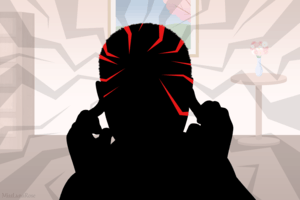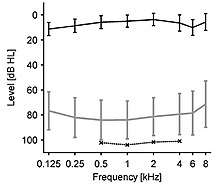Hyperacusis
Hyperacusis is highly debilitating and rare hearing disorder[1] characterized by an increased sensitivity to certain frequencies and volume ranges of sound (a collapsed tolerance to usual environmental sound). A person with severe hyperacusis has difficulty tolerating everyday sounds, which become painful or loud.[2][3] The prevalence of hyperacusis is 1 in 50,000 people[4].
| Hyperacusis | |
|---|---|
| Other names | Hyperacousis |
 | |
| Art by a victim of hyperacusis | |
| Specialty | Psychiatry, Neurology, Otolaryngology |
| Frequency | 1 in 50,000 |
Hyperacusis is often coincident with tinnitus. However, tinnitus is more common[5] and there are important differences between their involved mechanisms. [1]
Signs and symptoms
In hyperacusis, the symptoms are ear pain, annoyance, and general intolerance to many sounds that most people are unaffected by. Crying spells or panic attacks may result from the experience of hyperacusis. It may affect either or both ears.[6] Hyperacusis can also be accompanied by tinnitus. Hyperacusis can result in anxiety, stress and phonophobia. Avoidant behaviour is often a response to prevent the effects of hyperacusis and this can include avoiding social situations.
Associated conditions
Some conditions that are associated with hyperacusis[7] include:
|
Causes
The most common cause of hyperacusis is overexposure to excessively high decibel (sound pressure) levels.[2]
Some sufferers acquire hyperacusis suddenly as a result of taking ear sensitizing drugs, Lyme disease, Ménière's disease, head injury, or surgery. Others are born with sound sensitivity, develop superior canal dehiscence syndrome, have had a history of ear infections, or come from a family that has had hearing problems.
Some psychoactive drugs such as LSD, methaqualone, or phencyclidine (angel-dust) can cause hyperacusis.[14] An antibiotic, ciprofloxacin, has also been seen to be a cause, known as ciprofloxacin-related hyperacusis.[15]
Neurophysiological mechanisms
As one important mechanism, adaptation processes in the auditory brain that influence the dynamic range of neural responses are assumed to be distorted by irregular input from the inner ear. This is mainly caused by hearing loss related damage in the inner ear.[16]
Diagnosis

The basic diagnostic test is similar to a normal audiogram. The difference is that additionally to the hearing threshold at each test frequency also the lowest uncomfortable sound level is measured. This level is called loudness discomfort level (LDL), uncomfortable listening level (UCL), or uncomfortable loudness level (ULL). In patients with hyperacusis this level is considerably lower than in normal subjects, and usually across most parts of the auditory spectrum.[2][17]
Treatment
One possible treatment for hyperacusis is retraining therapy which uses broadband noise. Tinnitus retraining therapy, a treatment originally used to treat tinnitus, uses broadband noise to treat hyperacusis. Pink noise can also be used to treat hyperacusis. By listening to broadband noise at soft levels for a disciplined period of time each day, patients can rebuild (i.e., re-establish) their tolerances to sound. Although patients might not always make a complete recovery, the use of broadband noise usually gives some of them a significant improvement in their symptoms, especially if this is combined with counseling.[18][19][3][20]
Another possible treatment is cognitive behavioral therapy (CBT), which may also be combined with retraining therapy.[7][21]
Notable cases
- Musician Jason DiEmilio of Azusa Plane had hyperacusis. His story was told in BuzzFeed.[22]
- Musician Stephin Merritt has monaural hyperacusis in his left ear, which influences the instrumentation of his band, The Magnetic Fields, leads him to wear earplugs during performances and to cover his affected ear during audience applause.
- Musician Laura Ballance of Superchunk has hyperacusis and no longer tours with the band.
- American politician, activist, and film producer Michael Huffington has mild hyperacusis and underwent sound therapy after finding that running tap water caused ear pain.[23]
- Russian communist revolutionary, politician, and political theorist Vladimir Lenin was reported seriously ill by the latter half of 1921, having hyperacusis and symptoms such as regular headache and insomnia.[24]
- Musician Chris Singleton had hyperacusis, but made a full recovery.[25] His story was told in The Independent.[26]
- Musician Peter Silberman of The Antlers had hyperacusis and tinnitus which put his musical career on hold, but was quoted saying it died down to a 'manageable level'[27] He has now resumed his musical career.
- Voice actor Liam O'Brien has hyperacusis, and is quoted as having lost sleep during the time of diagnosis.[28]
References
- Knipper M, Van Dijk P, Nunes I, Rüttiger L, Zimmermann U (December 2013). "Advances in the neurobiology of hearing disorders: recent developments regarding the basis of tinnitus and hyperacusis". Progress in Neurobiology. 111: 17–33. doi:10.1016/j.pneurobio.2013.08.002. PMID 24012803.
- Tyler RS, Pienkowski M, Roncancio ER, Jun HJ, Brozoski T, Dauman N, Dauman N, Andersson G, Keiner AJ, Cacace AT, Martin N, Moore BC (December 2014). "A review of hyperacusis and future directions: part I. Definitions and manifestations" (PDF). American Journal of Audiology. 23 (4): 402–19. doi:10.1044/2014_AJA-14-0010. PMID 25104073.
- Pienkowski M, Tyler RS, Roncancio ER, Jun HJ, Brozoski T, Dauman N, Coelho CB, Andersson G, Keiner AJ, Cacace AT, Martin N, Moore BC (December 2014). "A review of hyperacusis and future directions: part II. Measurement, mechanisms, and treatment" (PDF). American Journal of Audiology. 23 (4): 420–36. doi:10.1044/2014_AJA-13-0037. PMID 25478787.
- "What Is Sound Sensitivity (Hyperacusis)?". WebMD. WebMD. Retrieved 7 July 2020.
- "Hyperacusis". British Tinnitus Association. Retrieved 9 June 2020.
- "Hyperacusis: An Increased Sensitivity to Everyday Sounds". American Academy of Otolaryngology–Head and Neck Surgery. 21 April 2014.
- Baguley DM (December 2003). "Hyperacusis". Journal of the Royal Society of Medicine. 96 (12): 582–5. doi:10.1177/014107680309601203. PMC 539655. PMID 14645606.
- Møller A (2011). Textbook of tinnitus. Totowa, N.J. London: Humana Springer distributor. p. 457. ISBN 978-1-60761-145-5.
- Baguley D (2007). Hyperacusis : mechanisms, diagnosis, and therapies. San Diego, CA: Plural Publishing Inc. p. 59. ISBN 978-1-59756-808-1.
- Granacher R (2008). Traumatic brain injury: methods for clinical and forensic neuropsychiatric assessment. Boca Raton, Fla. London: CRC Taylor & Francis distributor. p. 181. ISBN 978-0-8493-8139-3.
- Maciaszczyk K, Durko T, Waszczykowska E, Erkiert-Polguj A, Pajor A (February 2011). "Auditory function in patients with systemic lupus erythematosus" (PDF). Auris, Nasus, Larynx. 38 (1): 26–32. doi:10.1016/j.anl.2010.04.008. PMID 20576373.
- Desnick R (2001). Tay–Sachs disease. San Diego, Calif. London: Academic. p. 25. ISBN 978-0-08-049030-4.
- Zarchi O, Attias J, Gothelf D (2010). "Auditory and visual processing in Williams syndrome". The Israel Journal of Psychiatry and Related Sciences. 47 (2): 125–31. PMID 20733255.
- Barceloux D (2012). Medical Toxicology of Drug Abuse : Synthesized Chemicals and Psychoactive Plants. Hoboken, N.J: John Wiley & Sons. pp. 457, 507, and 616. ISBN 978-1-118-10605-1.
- "Ciprofloxacin Related Hyperacusis, From FDA reports". 2017.
- Brotherton H, Plack CJ, Maslin M, Schaette R, Munro KJ (2015). "Pump up the volume: could excessive neural gain explain tinnitus and hyperacusis?". Audiology & Neuro-Otology. 20 (4): 273–82. doi:10.1159/000430459. PMID 26139435.
- Sheldrake J, Diehl PU, Schaette R (2015). "Audiometric characteristics of hyperacusis patients". Frontiers in Neurology. 6: 105. doi:10.3389/fneur.2015.00105. PMC 4432660. PMID 26029161.
- Lindsey, Heather (August 2014). "Help for Hyperacusis: Treatments Turn Down Discomfort". The Hearing Journal. 67 (8): 22. doi:10.1097/01.HJ.0000453391.20357.f7. ISSN 0745-7472.
- Formby C, Hawley ML, Sherlock LP, Gold S, Payne J, Brooks R, Parton JM, Juneau R, Desporte EJ, Siegle GR (May 2015). "A Sound Therapy-Based Intervention to Expand the Auditory Dynamic Range for Loudness among Persons with Sensorineural Hearing Losses: A Randomized Placebo-Controlled Clinical Trial". Seminars in Hearing. 36 (2): 77–110. doi:10.1055/s-0035-1546958. PMC 4906300. PMID 27516711.
- Marc Fagelson, David M. Baguley (2018). Hyperacusis and Disorders of Sound Intolerance Clinical and Research Perspectives. Plural Publishing. pp. C15, C16. ISBN 978-1-94488-328-7.
- Aazh H, Moore BC, Lammaing K, Cropley M (September 2016). "Tinnitus and hyperacusis therapy in a UK National Health Service audiology department: Patients' evaluations of the effectiveness of treatments". International Journal of Audiology. 55 (9): 514–22. doi:10.1080/14992027.2016.1178400. PMC 4950421. PMID 27195947.
- "When Everyday Sound Becomes Torture".
- "Rejoining Society". June 2015.
- Shub 1966, p. 426; Rice 1990, p. 187; Service 2000, p. 435.
- "FAQs about Hyperacusis". Chris Singleton. Retrieved 2018-03-29.
- "I was allergic to sound". The Independent. 2010-06-01. Retrieved 2018-03-27.
- "How Peter Silberman Lost His Hearing, Then Rediscovered Sound". pastemagazine.com. Retrieved 2018-03-27.
- "'Between the Sheets: Liam O'Brien'". Critical Role. Retrieved 2018-10-10.
Further reading
- Andersson, David M. Baguley, Gerhard (2007). Hyperacusis : mechanisms, diagnosis, and therapies. San Diego: Plural Pub. ISBN 978-1597561044.
- "Decreased Sound Tolerance", by Pawel J. Jastreboff and Margaret J Jastreboff, in: "Tinnitus: theory and management", ed. James Byron Snow, 2004, ISBN 1-55009-243-X
External links
| Classification |
|---|